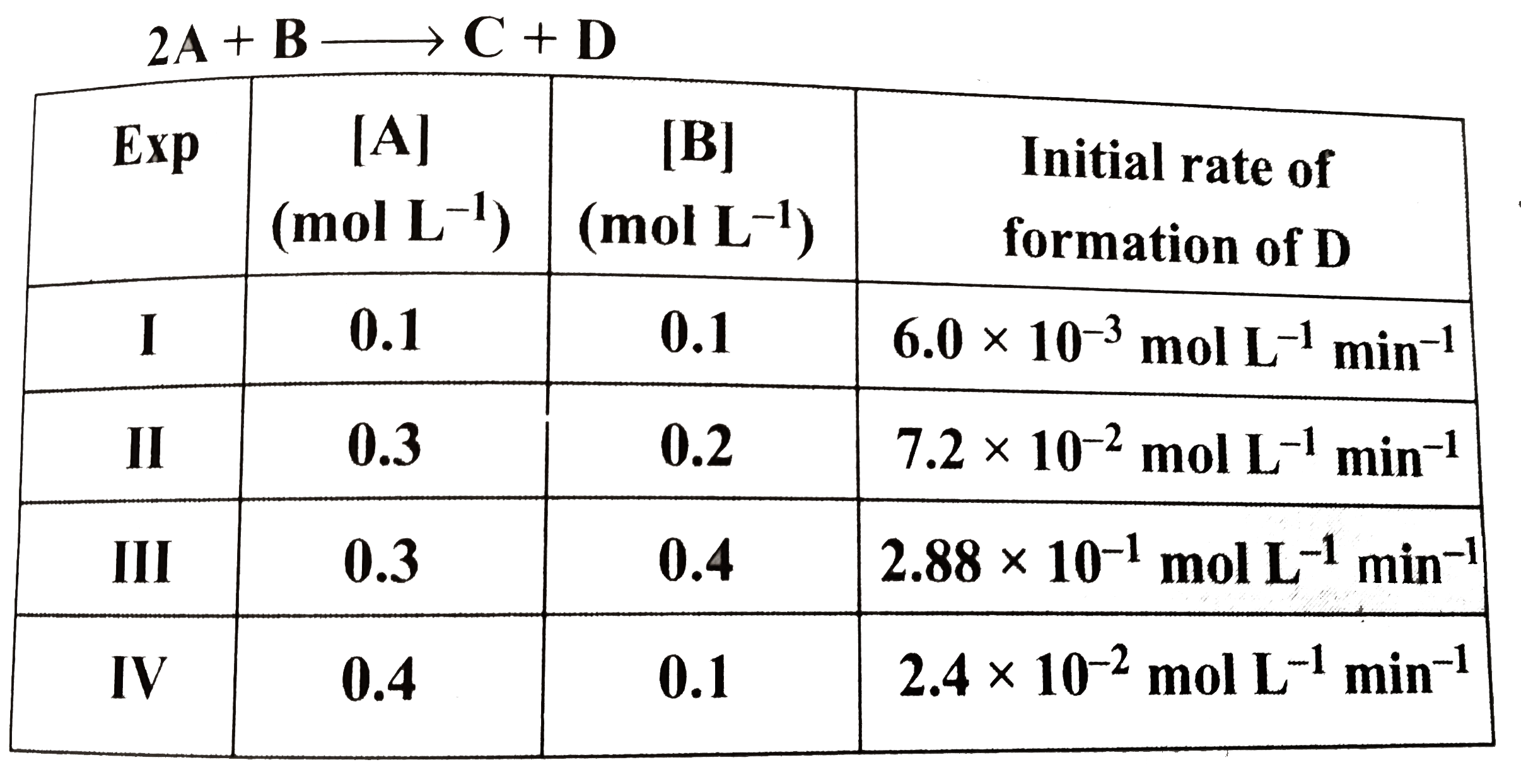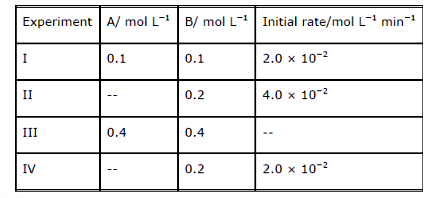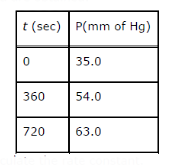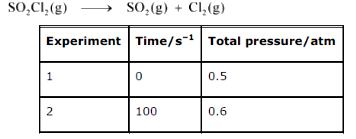Complete Solutions to Solved Examples of chapter CHEMICAL KINETICS of Class 12 book with complete answers and questions
| Class 12 | CHEMISTRY |
| Chapter | CHEMICAL KINETICS |
| NCERT | Solved Examples |
| Number Of Questions | 47 |
| Academic Year | 2023-24 |
From the concentrations of `C_(4)H_(9)Cl` (butyl chloride) at different times given below, calculate the average rate of the reaction:
`C_(4)H_(9)Cl +H_(2)Orarr C_(4)H_(9)OH+HCl`
during different intervals of time.
`{:(t//s,0,50,100,150,200,300,400,700,800),([C_(4)H_(9)Cl]//"mol"^(-1),0.100,0.0905,0.0820,0.0741,0.0671,0.0549,0.0439,0.0210,0.017):}`
10:55View SolutionThe decomposition of `N_(2)O_(5)` in `C Cl_(4)` solution at `318 K` has been studied by monitoring the concentration of `N_(2)O_(5)` in the solution. Initially, the concentration of `N_(2)O` is `2.33 M` and after `184 min`, it is reduced to `2.08 M`. The reaction takes place according to the equation:
`2N_(2)O_(5) rarr 4NO_(2) + O_(2)`
Calculate the average rate of this reaction in terms of hours, minutes, and seconds. What is the rate of Production of `NO_(2)` during this period?05:19View SolutionCalculate the overall order of a reaction which has the rate expresison.
(a) Rate`= k[A]^((1)/(2))[B]^((3)/(2))` , (b) Rate `= k[A]^((3)/(2))[B]^(-1)`01:41View SolutionIdentify the reaction order from each of the following rate constants.
(i) k `= 2.3xx10^(-5)Lmol^(-1)s^(-1)`
(ii) k `= 3xx 10^(-4)s^(-1)`04:45View SolutionThe initial concentration of `N_(2)O_(5)` in the following first order reaction:
`N_(2)O_(5)(g) rarr 2NO_(2)(g)+(1)/(2)O_(2)(g)`
was `1.24 xx 10^(-2) mol L^(-1)` at `318 K`. The concentration of `N_(2)O_(5)` after `60 min` was `0.20 xx 10^(-2) mol L^(-1)`. Calculate the rate constant of the reaction at `318 K`.02:49View SolutionThe following data were obtained during the first thermal decomposition of `N_(2)O_(5) (g)` at constant volume.
`2N_(2)O_(5) (g) rarr 2N_(2)O_(4) (g)+O_(2)(g)`
`|{:("S.No.","Time (s)","Total pressure (atm)"),(i.,0,0.5),(ii.,100,0.512):}|`
Calculate the rate constant.03:36View SolutionA first order reaction is found to have a rate constant `k= 5.5 xx 10^(-14)s^(-1)`. Find half-life of the reaction.
02:29View SolutionWhen reaction is completed 99.9%,`[R]_(n) = [R]_(0) - 0.999[R]_(0)`
04:13View SolutionThe rate constant of a reaction at `500 K` and `700 K` are `0.02s^(-1)`, respectively. Calculate the values of `E_(a)` and `A` at `500 K`.
04:46View SolutionThe first order rate constant for the decomposition of `C_(2)H_(5)I` by the reaction.
`C_(2)H_(5)I(g)rarrC_(2)H_(4)(g)+HI(g)`
at `600 K is 1.60xx10^(-5)s^(-1)`. Its energy of activation is `209 kJ mol^(-1)`. Calculate the rate constant at `700 K`03:29View SolutionIn a reaction, `2Ararr` Products the concentration of A decreases from `0.5` mol `litre^(-1)` to `0.4` mol `litre^(-1)` in `10` minutes. Calculate rate during this interval.
00:59View SolutionFor a reaction, `A+Brarr` Product, the rate law is given by `r=k[A]^((1)/(2))[B]^(2)`. What is the order of the reaction ?
01:30View SolutionThe conversion of molecules `X` to `Y` follows second order kinetics. If the concenration of `X` is increased to three times, how will it affect the rate of formation of `Y` ?
03:41View SolutionA first order reaction has a rate constant `1.15xx10^(-3)s^(-1)`. How long will `5g` of this reactant take to reduce to `3g`` ?
03:30View SolutionTime required to decompose `SO_(2)Cl_(2)` to half of its intial amount is `60 mi n.` If the decomposition is a first order reaction, calculate the rate constant of the reaction.
03:11View SolutionWhat will be effect of temperature on rate constant ?
02:12View SolutionThe rate of the chemical reaction doubles for an increase of 10K in absolute temperature from 298K. Calculate Ea.
05:00View SolutionThe activation energy for the reaction `:`
`2HI(g) rarr H_(2)(g)+I_(2)(g)`
is `209.5 kJ mol^(-1)` at `581K`. Calculate the fraction of molecules of reactants having energy equal to or greater than activation energy ?04:10View SolutionFrom the rate expression for the following reactions, determine their order of reaction and dimensions of the rate constants.
`a. 3NO(g) rarr N_(2)O(g),` Rate`=k[NO]^(2)`
`b. H_(2)O_(2)(aq)+3I^(-)(aq)+2H^(o+) rarr 2H_(2)O(l)+I_(3)^(-),` Rate`=k[H_(2)O_(2)][I^(-)]`
`c. CH_(3)CHO(g)rarr CH_(4)(g)+CO(g),` Rate`=k[CH_(3)CHO]^(3//2)`
`d. C_(2)H_(5)Cl(g) rarr C_(2)H_(4)(g)+HCl(g),` Rate `k[C_(2)H_(5)Cl]`05:42View SolutionFor the reaction `:`
`2A+B rarr A_(2)B`
the rate `=k[A][B]^(2)` with `k=2.0xx10^(-6)mol^(-2)L^(2)s^(-1)`. Calculate the initial rate of the reaction when `[A]=0.1 mol L^(-),[B]=0.2 mol L^(-1)`. Calculate the rate of reaction after `[A]` is reduced to `0.06 mol L^(-1)`.07:47View SolutionThe rate of decomposition of `NH_(3)` on platinum surface is zero order. What are rate of production of `N_(2)` and `H_(2)` if `k=2.5 xx 10^(-4)Ms^(-)`?
05:14View SolutionThe decomposition of dimethyl ether leads to the formation of `CH_(4),H_(2),` and `CO` and the reaction rate is given by
Rate `=k[CH_(3)OCH_(3)]^(3//2)`
The rate of reaction is followed by increase in the pressure in a closed vessel , so the rate can also be expressed in terms of the partial pressure of dimethyl either, `i.e., `
Rate `=k[p_(CH_(3)OCH_(3))]^(3//2)`
If the pressure is measured in bar and time in minutes, then what are the units of rate and rate constant ?01:50View SolutionMention the factors that affect the rate of a chemical reaction.
02:12View SolutionA reaction is second order with respect to a reaction. How is the rate of reaction affected if the
(a) doubled, (b) reduced to `1//2`?01:21View SolutionWhat is the effect of temperature on the rate constant of a reaction ? How can this temperature effect on rate constant be represented quantitatively ?
02:26View SolutionIn a pseudo first order hydrolysis of ester in water the following results were obtained:
`{:(t//s,0,30,60,90),(["Ester"],0.55,0.31,0.17,0.085):}`
(i) Calculate the average rate of reaction between the time interval `30` to `60` seconds.
(ii) Calculate the pseudo first order rate constant for the hydrolysis of ester.04:00View SolutionA reaction is first order in `A` secod order in `B`:
(i) write differential rate equation.
(ii) How is the rate affected when the concentration of `B` is tripled ?
(iii) How is the rate affected when the concentration of both `A` and `B` is doubled?02:05View SolutionIn a reaction between A and B, the initial rate of reaction was measured for different initial concentration of A and B as given below:
`{:(A//M,0.20,,0.20,0.40),(B//M,0.30,,0.10,0.05),(r_(0)//M s^(-1),5.07xx10^(-5),,5.07xx10^(-5),7.6xx10^(-5)):}` Calculate the order of reaction w.rt. A and B.04:19View SolutionThe following rate data were obtained at `303 K` for the following reaction:
`2A + B rarr C + D`

What is the rate law? What is the order with respect to each reactant and the overall order? Also calculate the rate constant and write its units.10:00View SolutionThe reaction between A and B is first order with respect to A and zero order with respect to B. Fill in the blanks in the following table:
 05:09View Solution
05:09View SolutionCalculate the half life of a first order reaction from their rate constants given below `:`
`a. 200s^(-1)`,`b. 2 mi n^(-1)`,`c.4years^(-1)`03:55View SolutionThe half life for radioactive decay of `.^(14)C` is 5730 years. An archaeological artifact containing wood had only `80%` of the `.^(14)C` found in a living tree. Estimate the age of the sample.
03:12View SolutionThe rate constant for the first order reaction is `60 s^(-1)`. How much time will it take to reduce the concentration of the reactant to `1//16th` value ?
01:25View SolutionDuring nuclear explosion, one of the products is `""^(90)Sr` with half`-` life of `28.1 `years. If `1 mug` of `.^(90)Sr` was absorbed in the bones of a newly born baby instead of calcium, how much of its will remain after 10 years and 60 years if it is not lost metabolically.
05:24View SolutionFor a first order reaction, show that the time required for `99%` completion is twice the time required for the completion of `90%` of reaction.
04:36View SolutionA first order reaction takes `40 mi n ` for `30%` decomposition. Calculate `t_(1//2)`.
05:11View SolutionFor the decomposition of azoisopropane to hexane and nitrogen at 54
K, the following data are obtained.

Calculate the rare constant.03:32View SolutionThe following data were obtained during the first order thermal
decomposition of `SO_(2)Cl_(2)` at a constant volume `SO_(2)Cl_(2)(g)to SO_(2)(g)+Cl_(2)(g)`

Calculate the rate of the reaction when total pressure is 0.65 atm06:08View SolutionThe rate constant for the decomposition of `N_(2)O_(5)` at various temperatures
is given below:

Draw a graph between ln k and 1/T and calculate the values of A and
`E_(a)`. Predict the rate constant at `30^(@)` and `50^(@)C`.09:56View SolutionThe rate constant for the decomposition of hydrocarbons is `2.418xx10^(-5)s^(-1)` at `546K`. If the energy of activation is `179.9kJ mol^(-1)`, what will be the value of pre`-`exponential factor?
04:56View SolutionConsider a certain reaction `A rarr` Products with `k=2.0xx10^(-2)s^(-1)`. Calculate the concentration of `A` remaining after `100s` if the initial concentration of `A` is `1.0 mol L^(-1)`.
02:50View SolutionSucrose decomposes in acid solution into glucose and fructose according to the first order rate law, with `t_(1//2)=3.00hr.` What fraction of sample of sucrose remains after `8 hr` ?
03:30View SolutionThe decomposition of hydrocarbon follows the equation `k=(4.5xx10^(11)s^(-1))e^(-28000K//T)`
Calculate `E_(a)`.02:10View SolutionThe rate constant for the first order decomposition of a certain reaction is described by the equation
`log k (s^(-1)) = 14.34 - (1.25 xx 10^(4)K)/(T)`
(a) What is the energy of activation for the reaction?
(b) At what temperature will its half-life period be `256 min`?04:26View SolutionThe decomposition of `A` into product has value of `k` as `4.5xx10^(3)s^(-1)` at `10^(@)C` and energy of activation of `60kJmol^(-1)`. At what temperature would `k` be `1.5xx10^(4)s^(-1)?`
04:45View SolutionThe time required for `10%` completion of a first order reaction at `298K` is equal to that required for its `25%` completion at `308K` . If the value of `A` is `4xx10^(10)s^(-1)`, calculate `k` at `318K` and `E_(a)`.
06:50View SolutionThe rate of a reaction quadruples when the temperature changes from `293K` to `313K`. Calculate the energy of activation of the reaction assuming that it does not change with temperature.
03:33View Solution
Solved Examples questions and complete solutions for chapter CHEMICAL KINETICS of NCERT CHEMISTRY(HINGLISH) of Class 12
